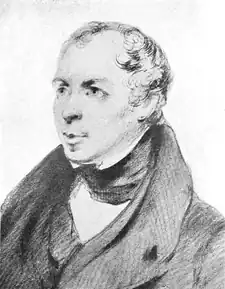Thomas Drummond (botanist)
Thomas Drummond (1793[1] — March 1835), was a Scottish botanical collector.

Life
Thomas Drummond was the younger brother of the botanist James Drummond. He was born in Scotland, and during the early part of his life was at Don's nursery, Forfar. He first became known to botanists by his distributed sets of mosses, ‘Musci Scotici,’ and afterwards was attached as assistant-naturalist to Dr. Richardson in Sir John Franklin's second land expedition.
He accordingly sailed from Liverpool on 16 February 1825 and reached New York on the 15th of the following month. The expedition moved westward by the Hudson River and lakes Ontario and Winnipeg to the Mackenzie River. Drummond quit the main party at Cumberland House to explore the Rocky Mountains.
On 3 June 1827 Drummond met David Douglas at Carlton House as Douglas was venturing overland from Fort Vancouver toward York Factory, Manitoba on his return trip to London, collecting for the Royal Horticultural Society.
In the spring of 1831 Drummond journeyed on foot by the Alleghany Mountains, reaching St. Louis in July, where he fell ill. In consequence of this delay he was unable to join the fur traders on their expedition to the north. He therefore was compelled to confine his explorations to New Orleans and thereabouts. Hence he made a botanical tour in Texas; at Velasco an attack of cholera prostrated him, but on recovering he continued his labours. Drummond collected along the Brazos, Colorado and Guadalupe Rivers, spending almost two years collecting plants and birds in Texas. His plant specimens from Texas were widely distributed in Europe and stimulated later botanical exploration. (Geiser, 1949) He embarked finally for Havana on 9 February 1835 and died at that port early in March. The plants sent home by Drummond were described by Sir William Hooker in his Flora Boreali-Americana, his Journal of Botany, and Companion to the Botanical Magazine.
He and his brother, James are honoured in 1855,[2] in the Australian plant genus of Drummondita (in the Rutaceae family).[3]
References
- "Thomas Drummond (1793–1835)" (PDF). Friends of the Forfar Botanists. Retrieved 11 May 2021.
- "Drummondita Harv. | Plants of the World Online | Kew Science". Plants of the World Online. Retrieved 24 August 2021.
- Burkhardt, Lotte (2018). Verzeichnis eponymischer Pflanzennamen – Erweiterte Edition [Index of Eponymic Plant Names – Extended Edition] (pdf) (in German). Berlin: Botanic Garden and Botanical Museum, Freie Universität Berlin. doi:10.3372/epolist2018. ISBN 978-3-946292-26-5. S2CID 187926901. Retrieved 1 January 2021.
- International Plant Names Index. Drumm.
Other sources
- Nisbet, Jack. The Collector: David Douglas and the Natural History of the Northwest (2009) Sasquatch Books. ISBN 1-57061-613-2
- Harvey, Athelstan George. Douglas Of The Fir: A Biography Of David Douglas Botanist (1947) Harvard University Press.
- Lindsay, Ann and Syd House. "The Tree Collector: The Life and Explorations of David Douglas" (1999,2005) Aurum Press Ltd. ISBN 1-84513-052-9
- Geiser, Samuel Wood. "Naturalists of the Frontier" (1949) Southern Methodist University Press
![]() This article incorporates text from a publication now in the public domain: "Drummond, Thomas (d.1835)". Dictionary of National Biography. London: Smith, Elder & Co. 1885–1900.
This article incorporates text from a publication now in the public domain: "Drummond, Thomas (d.1835)". Dictionary of National Biography. London: Smith, Elder & Co. 1885–1900.
External links
Further reading
- "Thomas Drummond (1793–1835)" (PDF). Friends of the Forfar Botanists. Retrieved 11 May 2021.